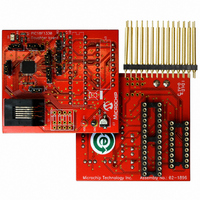AC162078 Microchip Technology, AC162078 Datasheet - Page 43

AC162078
Manufacturer Part Number
AC162078
Description
HEADER INTRFC MPLAB ICD2 18F1330
Manufacturer
Microchip Technology
Datasheet
1.AC162078.pdf
(318 pages)
Specifications of AC162078
Accessory Type
Transition Header
Lead Free Status / RoHS Status
Not applicable / Not applicable
For Use With/related Products
ICD2
Lead Free Status / RoHS Status
Lead free / RoHS Compliant, Not applicable / Not applicable
Available stocks
Company
Part Number
Manufacturer
Quantity
Price
Company:
Part Number:
AC162078
Manufacturer:
MICROCHIP
Quantity:
12 000
- Current page: 43 of 318
- Download datasheet (3Mb)
5.5
PIC18F1230/1330 devices incorporate three separate
on-chip timers that help regulate the Power-on Reset
process. Their main function is to ensure that the device
clock is stable before code is executed. These timers
are:
• Power-up Timer (PWRT)
• Oscillator Start-up Timer (OST)
• PLL Lock Time-out
5.5.1
The Power-up Timer (PWRT) of PIC18F1230/1330
devices is an 11-bit counter which uses the INTRC
source as the clock input. This yields an approximate
time interval of 2048 x 32 s = 65.6 ms. While the
PWRT is counting, the device is held in Reset.
The power-up time delay depends on the INTRC clock
and will vary from chip to chip due to temperature and
process variation. See DC parameter 33 for details.
The PWRT is enabled by clearing the PWRTEN
Configuration bit.
5.5.2
The Oscillator Start-up Timer (OST) provides a
1024 oscillator cycle (from OSC1 input) delay after the
PWRT delay is over (parameter 33). This ensures that
the crystal oscillator or resonator has started and
stabilized.
The OST time-out is invoked only for XT, LP, HS and
HSPLL modes and only on Power-on Reset, or on exit
from most power-managed modes.
TABLE 5-2:
2009 Microchip Technology Inc.
HSPLL
HS, XT, LP
EC, ECIO
RC, RCIO
INTIO1, INTIO2
Note 1:
Configuration
2:
Oscillator
Device Reset Timers
66 ms (65.5 ms) is the nominal Power-up Timer (PWRT) delay.
2 ms is the nominal time required for the PLL to lock.
POWER-UP TIMER (PWRT)
OSCILLATOR START-UP TIMER
(OST)
TIME-OUT IN VARIOUS SITUATIONS
66 ms
66 ms
(1)
PWRTEN = 0
+ 1024 T
(1)
66 ms
66 ms
66 ms
+ 1024 T
Power-up
OSC
(1)
(1)
(1)
+ 2 ms
OSC
(2)
and Brown-out Reset
(2)
5.5.3
With the PLL enabled in its PLL mode, the time-out
sequence following a Power-on Reset is slightly
different from other oscillator modes. A separate timer
is used to provide a fixed time-out that is sufficient for
the PLL to lock to the main oscillator frequency. This
PLL lock time-out (T
the oscillator start-up time-out.
5.5.4
On power-up, the time-out sequence is as follows:
1.
2.
The total time-out will vary based on oscillator
configuration and the status of the PWRT. Figure 5-3,
Figure 5-4, Figure 5-5, Figure 5-6 and Figure 5-7 all
depict time-out sequences on power-up, with the
Power-up Timer enabled and the device operating in
HS Oscillator mode. Figures 5-3 through 5-6 also apply
to devices operating in XT or LP modes. For devices in
RC mode and with the PWRT disabled, there will be no
time-out at all.
Since the time-outs occur from the POR pulse, if MCLR
is kept low long enough, all time-outs will expire.
Bringing MCLR high will begin execution immediately
(Figure 5-5). This is useful for testing purposes or to
synchronize more than one PIC18FXXXX device
operating in parallel.
1024 T
PWRTEN = 1
After the POR pulse has cleared, PWRT time-out
is invoked (if enabled).
Then, the OST is activated.
1024 T
OSC
PIC18F1230/1330
—
—
—
PLL LOCK TIME-OUT
TIME-OUT SEQUENCE
+ 2 ms
OSC
(2)
PLL
) is typically 2 ms and follows
Power-Managed Mode
1024 T
1024 T
Exit from
DS39758D-page 43
OSC
—
—
—
+ 2 ms
OSC
(2)
Related parts for AC162078
Image
Part Number
Description
Manufacturer
Datasheet
Request
R

Part Number:
Description:
Manufacturer:
Microchip Technology Inc.
Datasheet:

Part Number:
Description:
Manufacturer:
Microchip Technology Inc.
Datasheet:

Part Number:
Description:
Manufacturer:
Microchip Technology Inc.
Datasheet:

Part Number:
Description:
Manufacturer:
Microchip Technology Inc.
Datasheet:

Part Number:
Description:
Manufacturer:
Microchip Technology Inc.
Datasheet:

Part Number:
Description:
Manufacturer:
Microchip Technology Inc.
Datasheet:

Part Number:
Description:
Manufacturer:
Microchip Technology Inc.
Datasheet:

Part Number:
Description:
Manufacturer:
Microchip Technology Inc.
Datasheet:











